Note that the original presentation of this paper was illustrated with slides. To give a feel for this, there are a number of small thumb nails included along with the body of the text. Each of these can be clicked to bring you the full sized image. (There also may be some repetition of these images from elsewhere in this series of information.) Due to the size of the paper it is divided into two parts.
"From the Fury of the North Men, Oh Lord, deliver us..." spoke a terror stricken English priest in the early 800's. The Viking raiders that seemed to virtually explode out of Scandinavia starting in the last decade of the 700s were just the most visible element of a complex culture. The Norse people of Sweden, Denmark and Norway, shared a common religion, world view, material culture, technologies, writing system, and related languages. All of these were quite distinctive from those of the peoples living to the south and west of them. Their characteristics of physical toughness, fierce individuality, skill in arms and nautical brilliance enabled them to have such an impact on the rest of Europe that the period there that stretches from 793 to 1066 is commonly referred to as the Viking Age.
Some time in the last decade of the first millennium, the first groups of Norse explorers arrived on the shores of North America. Like other Europeans who would follow centuries latter, these bold men and women were seeking resources, wealth, and perhaps were driven by the desire to make their mark. They would delineate the furthest western expansion of a culture already famous for its daring voyages. They would leave little behind them when they left eastern Canada, a mere hand full of artifacts and a the ruins of a couple of houses. Most importantly, the tales of their adventures would be retold for generations until these took on the form of legend, the core of truth lying encased within the story tellers art.
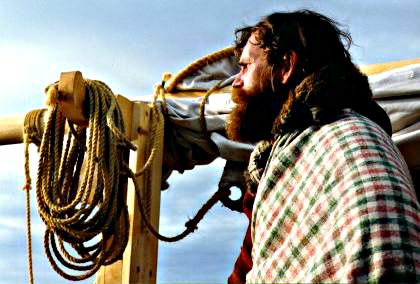
|
|
In the early 1960s, the Norwegian researchers Helge Ingstad and Anne Stine would use the clues buried in these same tales to help in their search for archaeological evidence of the Norse in Eastern Canada. Their investigations would eventually lead them to uncover the remains of a group of turf houses at L 'Anse aux Meadows in Northern Newfoundland. Along the grass covered terrace that parallels the shore they excavated the remains of a total of eight structures of a type also seen in Iceland and Greenland. Although the actual number of artifacts was small, the remains of a bog iron foundry, soapstone spindle whorl and bronze ring headed pin all pointed to Norse occupation. Carbon 14 analysis of wooden and charcoal fragments placed the date of the site's use to around 1000 AD. Taken altogether, the only conclusion that could be drawn was that this was an outpost built by the Norse, about the time of Lief Eirikson.
The site at L 'Anse aux Meadows became a Canadian national park in 1977, and a year later became the first UNESCO World Heritage Site. In 1980 Parks Canada reconstructed one of the main longhouses, along with two of the smaller buildings, just north of the location of the original structures. Latter a modern interpretive centre was constructed on the bluff that rises about 500 m in shore from the ruins. This building houses artifacts from the site, various reproductions that help illustrate the 'World of the Norse', a small theatre, and administrative facilities. Educational services for the visiting public at this point were provided by a staff of trained guides. Despite the small physical size of the site, and its remote location at the very tip of Newfoundland's Great Northern Peninsula, over 20,000 people visit over the three month operating season each year.
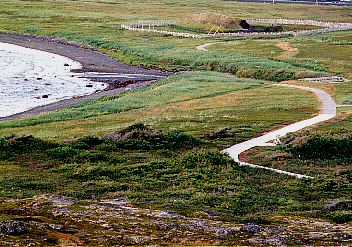 |
|
In 1996, Parks Canada sponsored a two week demonstration of a living history program utilising costumed interpreters. "The Norse Encampment" had been developed by myself as a special educational presentation that was originally part of a community Mediaeval festival (in Orangeville Ontario). The program at L 'Anse aux Meadows utilised a core group of four professional interpreters, surrounded by a collection of approximately 250 individual artifact reproductions. The costumed staff utilised a number of different interpretive levels and techniques to bring the Viking Age to life. On the part of Parks Canada, it was an opportunity to evaluate the potential suitability and usefulness of a living history program at very low cost. For myself and the interpreters involved, it was a chance to refine both the program and our skills. Taken altogether, the Norse Encampment program proved a resounding success, significantly increasing admissions and visitor satisfaction with the site.
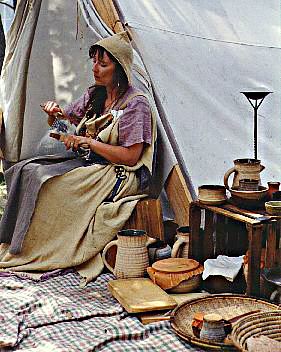 |
 |
| |
|
With the utility of living history as part of the educational programming at L 'Anse aux Meadows demonstrated, work was started on a regular seasonal presentation. I was contracted by the Viking Trails Tourism Association, working in partnership with Parks Canada and Human Resources & Development Canada. The entire interpretive program was to be designed and implemented, the required reproductions had to be created (or commissioned), plus the training of six local people as the historic interpreters. The "Viking Encampment" opened in mid June of 1997, and remains a daily feature at the site into its second operating year. Almost universally, the visiting public remains enthusiastic about the work of the interpretive staff. More importantly the program has also been seen by a number of researchers and archaeologists familiar in the Viking Age, who all have reported positively on both its historical content and educational value.
The mission of the Viking Encampment, however, was not to simply to entertain the public, or to attempt to create a simple 'snapshot' of a specific place and time from history. The intent of the re-enactment was to provide the museum visitor with an insight into the overall culture of the Norse, to create an impression of what a people and their world were like. A collection of reproduction artifacts would be placed in context, and seen in daily use. Costumed staff would employ an number of interpretive levels, portraying characters which are bolder than life to better illustrate specific attitudes. In this way, everything that was included in the presentation, and how each element was employed, was part of an overall design. Reflecting on the process of researching, creating and implementing this interpretive program may prove of interest and value to museum professionals at all levels, from the working interpreter to the academic. The lessons from the Viking Age include those that are practical, technical and theoretical - and sometimes things totally unexpected!
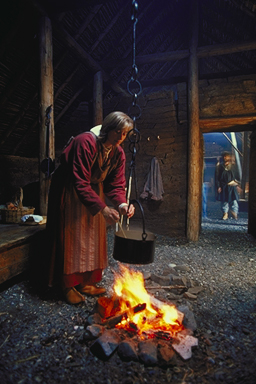 |
|
| "The Norse Encampment will provide a unique educational
resource
within the larger framework of the L 'Anse aux Meadows National
Historic
Site. It will portray an ethnographic study of the Norse in North
America,
circa 1000 AD. Specifically, the reenactment will represent aspects of
daily life as it would have been carried out at the Vinland outpost and
to
provide insights into the larger framework in Norse culture in general.
The
presentation will be centred within the recreated turf buildings and
adjacent compound. A number of reproduction artifacts will be
introduced:
cooking gear, tools, navigation equipment and household goods like beds
and
chests. The staff will be made up of costumed interpreters who will
portray historic characters. Small scale physical demonstrations of
domestic and craft skills will be undertaken throughout the day.
The intent of this reenactment is to provide the public an opportunity learn in an interactive atmosphere about an early phase of Canadian History, i.e. the Norse presence in Eastern Canada. The Encampment will also provide an opportunity for research into technologies of this period, employing experimental archaeology, and present these to the general public." |
One of the overall problems with designing any living history program lies in deciding just which original sources will be selected as the prototypes on which not only overall content, but even individual physical objects, are to be based upon. In any translation from 'pure' archaeological and historic research into public programming, a wide number of factors interact to influence what is placed before the public. Many of these effects are only slightly felt, if at all, with a site portraying life of the Settlement period, a 'mere' 150 years ago. First of all, there is the problem of how the accidental nature of artifact preservation never leaves much more than a shadowy outline of the original life of any site. What controls the survival of an object often has little to do with its cultural context within the original period of study. Often the most common objects are actually the least likely to survive, do to excessive wear, less durable materials, or the lack of care given to the everyday. One obvious solution is to examine materials from a number of related sites, thus to provide a larger number of physical samples to chose from. The problem then becomes one of judgment. How far from the chosen focus, in item, geography, or even cultural details, does one look? Obviously, the further from your target site you move, the more likely that the references provided by other locations will not apply. Original document sources become not only harder to find, but also increasingly unreliable, especially in fine details, the further back in time one goes. Unlike other North American museums, that rely heavily on original documents of all kinds for their sources, any program dealing with the Viking Age must be based almost solely on archaeology.
 |
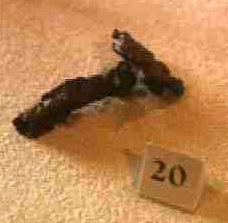 |
| |
|
These aspects were especially troublesome in the case of the Viking Encampment program for L 'Anse aux Meadows, where a full 1000 years has passed since Norse occupation. As has already been stated, the physical remains uncovered on the site were extremely limited both due to the early date of the site and also the marginal nature of the original occupation. There were only a dozen or different types of items found. (Considering groups of like objects as consisting of a single type: for example there were over 100 rivet fragments recovered, but they primarily consist of the same 'boat rivet' type.)(2) Obviously any attempt to re-create the daily life in Vinland would necessitate the examination of a number of other locations. In a program such as this, every attempt was made to focus as closely as possible on the physical culture of the Norse who made up those ship crews at the turn of the first millennium. To this end, the first likely source to be considered would occupation sites from the Norse colony on Greenland, which itself has over a 400 year occupation record. Unfortunately, these also are very limited as artifact sources, for many of the same reasons as is the case at L 'Anse aux Meadows. The next step would was Iceland, the original homeland of many of the potential Greenland colonists. In the end it in fact it proved necessary to utilise a very wide selection of archaeological sites for artifact and cultural prototypes. To provide for the original artifacts required as samples for tools and domestic ware it was necessary to examine materials from major sites such the Oseberg (Norway, early 800s), Coppergate (York, England) and Woods Quay (Dublin, Ireland - both late 900s), and Mastermyr, (Norway, dated c. 1150 AD). Individual sample items ranged from sites throughout the Norse world and the Viking Age. Where ever possible, prototypes were selected from a physical chain that started in L 'Anse aux Meadows and extended back to Norway, and as close the date of 1000 AD as was possible. For the Viking Encampment, the artifacts chosen for reproduction represented an amalgamation of items from all the disparate locations listed above. The objects selected were all of common types, widely used throughout the duration and geographical spread of the Viking Age. It should be noted that it cannot be proven that this exact selection of goods was in fact specifically present at L 'Anse aux Meadows in 1000 AD. It is felt, however, that despite the physical and temporal spread utilised, the selection made was reasonable within the general context of Norse culture and custom.
A graphic example of this process in action can be seen in the selection method employed for the blacksmiths tools that were included in the Viking Encampment. The working of iron is one of the most important parts of the L'anse aux Meadows story. The remains of bloomery slag, a charcoal pit and what has been interpreted as a specially constructed foundry building all point to the conclusion that the Norse processed local bog iron into approximately 3 kg of metallic wrought iron. (3) The discovery of these iron remains was one of the proofs that the site was European in origin, rather than constructed by Native North Americans. It also marks the first documented processing of iron on the continent, predating the next claimant to this event by over six hundred years (Jamestown, Virginia at about 1615). Obviously, the production of iron by the original Norse inhabitants was an important point to be illustrated within the interpretive program. The simplest way to introduce this subject was through the inclusion in the display in a set of blacksmiths tools.
The problem arose in the search for Viking Age prototypes. The basic tools of the smith; hammers, tongs and punches, are relatively common in Norse archaeological finds, so finding suitable prototypes for these was not difficult. Artifact reproduction was made simpler by the fact that the basic shape, size and construction of these basic tools has remained almost unchanged through the centuries. The two major pieces of blacksmiths equipment, the bellows and the anvil, presented the major challenge in determining prototypes.
Viking Age bellows, used to increase the temperature of a charcoal forge or smelting fire, exist only as fragments - when at all. Not too surprisingly with an object constructed of wood and leather, damaged bellows plates were likely turned into fire wood when worn out to be serviceable any longer. In the end the prototype for the bellows was taken from an illustration of a blacksmith at work carved in wood on the stave church at Hyllestad, Norway, dated to the late 1100s. In this case the best available historic source is a secondary one, lacking in detail, and in fact outside of the time period under consideration.
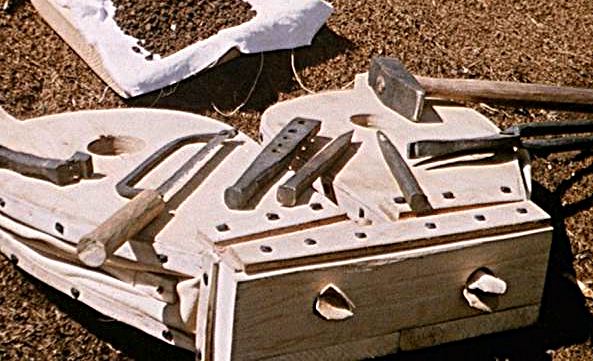 |
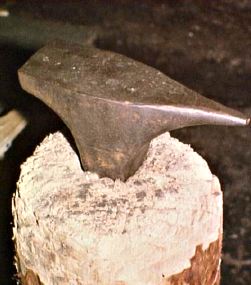 |
| |
|
Norse period anvils are uncommon verging on rare, especially when one considers the abundance and quality of forged objects from the period. Most Viking anvils tend to be of small size, roughly ten cm cubes, and range around five kg in weight. Even so, this mass of iron represented a considerable investment in raw metal, and the physical labour involved in working a block this size was considerable given the technology of the period. (In many cases flat topped rocks were more likely to be used as work surfaces by Norse blacksmiths.) The prototype anvil used for the Encampment was actually an unusually large and elaborate one by period standards. The original artifact selected weighs about 15 kg, was found at Novgorod, Russia, and dates to about 1000 AD. (4) My interpretation of this specific artifact is that it likely was the equipment of a master smith, and certainly would have been an extremely 'expensive' one, both in terms of materials and effort to create it. With the marginal nature of the outpost at L' Anse aux Meadows, there is no reason to assume the presence of the kind of highly skilled craftsman that the presence of such an object indicates. Why then was this artifact chosen as the prototype instead of something less elaborate?
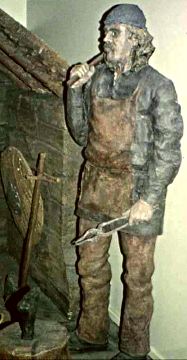 |
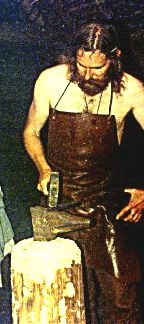 |
| |
|
The main reason lies in the earlier display work done at the site in conjunction with the main interpretive centre in the early 1980s. Along with a number of resin cast copies of various period objects there were several dioramas produced. These contain a number of human figures (strongly influenced by the illustrations of Ake Gustavsson)(5) that spotlight the artifacts found at the site and places them into context. One of these figures is posed working at an anvil which itself is clearly based on the sample from Novgorod mentioned above. Despite the fact that I believe that this style of anvil, and the master smith it implies, never was physically present at L 'Anse aux Meadows, this object was again used as the prototype. This was done not to further validate the work of earlier designers, but to preserve the continuity of the exhibits over the entire site. The average museum visitor will not have the background in detail to appreciate the differences in interpretation and research that would be represented by the inclusion of one style of object over another. They will however, immediately notice and comment upon any discrepancies in information or presentation between one source at the site and another.
A very good example of the difference between a scholarly and an practical approach to re-creating an artifact can be shown by considering the turf houses built at L 'Anse aux Meadows by Parks Canada. The original house walls revealed by archaeology at the site are little more than the collapsed remains of the very bottoms, with lines of post holes to indicate the positions of the original framing timbers. When the reconstructions were carried out in the 1980s, the remains of the Stong House from Iceland, and its reconstruction, were used as the prototypes for the missing upper sections. Stong is basically contemporary to the construction at L 'Anse aux Meadows (buried by volcanic ash in 1104) and is also from roughly the same cultural group. (It was Icelanders who made up many of the original Greenland settlement, hence the members of the Vinland expeditions.) The one real, and as it turned out extremely important, difference was in the physical positioning, and hence local environments, of the two locations. The Stong farm lies about 50 miles inland, and the prevailing winds blow from the west. The door of the Stong house is on side of the building towards the prevailing winds at the site. The upper portion of the structure was not preserved, so the exact location of the smoke holes originally used here is not known. When the reconstruction was done, the smoke holes were located in the centre of the roof - for no better reason that it proved the easiest for the contractor doing the work! In existing houses in Iceland, built in the same tradition as these ancient structures, the pattern is to place the smoke holes in the down wind slope of the roof, just down from the peak. As the wind rolls over the roof, it tumbles, creating an area of relatively low pressure just above the smoke holes which (with properly fitted covers) helps extract smoke from the cooking fires set in the central floor of the building. By opening the door, the prevailing wind would be pushed into the building and up and out the smoke holes, if even more draft was required.
The physical environment at L 'Anse aux Meadows is quite different. The houses are built along the shore, almost close enough to toss garbage from the doors straight into the ocean at high tide. As well, the site is located at the very tip of the Great Northern Peninsula, and although it is at the base of the small Epres Bay, the location is basically surrounded by water on three sides. Consequentially the winds at L 'Anse aux Meadows are constant, strong - and seem to shift direction every twenty minutes. Utilising the Stong / Iceland prototype, the smoke holes were placed on the eastern side of the roof - away from the 'prevailing' westerlies. The door openings were also on the east, conforming to the outline of the original building outline, although a door originally found on the western wall was omitted in the reconstruction. When fitting the wooden board covers for the smoke holes, the panels where hinged to swing inwards - despite the fact that it is far more practical to have them swing out and up. This was done for modern day security considerations, it was easier to secure these inward swinging covers. The problem that these related factors created was not immediately obvious, as the buildings were only occupied briefly by staff and visitors during guided tours, and fires were only built inside occasionally.
With the constant occupation and day long use of fires for light, heat and cooking demonstrations by the staff during the new interpretive program the problem with the building's layout became instantly obvious. Well over half the time, an offshore east wind was forcing smoke back down through the smoke holes into the building interior. With the only doors on the same side as the smoke holes, there was no way to create a cross draft to clear the room. (This was further exaggerated by the fact the doors had to be kept constantly open to receive the public.) With the covers swinging inwards, not only was the frequent rain able to pelt the interior, the roll of air from any west wind was actually pushing smoke back inside as well. Taken altogether, it was obvious that the original structure would have to been equipped with smoke holes on both sides of the roof - and with covers that swung up. Constant tinkering with the position of the covers, and just which combination of smoke holes and doors would have been opened, would have been required to allow the interior rooms to remain habitable. It seems clear that pure scholarship was hardly up to the challenge presented by practical application in this instance
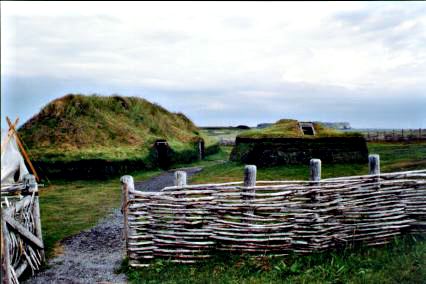 |
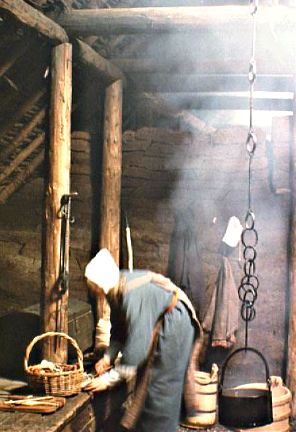 |
| |
|
